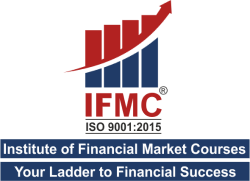
COMMODITY MARKET MOCK TEST DEMO
IFMC Institute®
Q.1 In derivatives the underlying asset can be___________
A derivative is a product whose value is derived from the value of one or more underlying variables or assets in a contractual manner. The underlying asset can be equity, forex, commodity or any other asset.
Q.2 Which of the following regulates the forward/futures contracts in commodities all over India?
The Forward Contracts (Regulation) Act, 1952, regulates the forward/ futures contracts in commodities all over India. As per this Act, the Forward Markets Commission (FMC) continues to have jurisdiction over commodity forward/ futures contracts.
Q.3 When was a derivative trading in securities introduced in India?
Q.4 Derivatives are securities under the ___ and hence trading of derivatives is governed by the regulatory framework under the_________.
The Securities Contracts (Regulation) Act, 1956 defines 'derivative' to include -A security derived from a debt instrument, share, loan whether secured or unsecured, risk instrument or contract for differences or any other form of security. A contract which derives its value from the prices, or index of prices, of underlying securities.
Q.5 What are the types of derivative?
All are the product of derivative market. Forward is a part of OTC market, future & option is a exchange trade based.
Q.6 Hedgers use the future or options markets to for which purpose?
Hedgers face risk associated with the price of an asset because hedger used derivative market only to bear their loss which he earned in different market (capital & physical market).
Q.7 Which of the following work at making profits by advantage of discrepancy between prices of the same product across different markets?
Arbitragers work in two different market or with option strategy for example, they see the futures price of an asset getting out of line with the cash price, they would take offsetting positions in the two markets to lock in the profit.
Q.8 Which of the following participants who wish to bet on future movements in the prices of an asset?
Futures and options contracts can give them leverage; that is, by putting in small amounts of money upfront, they can take large positions on the market. As a result of this leveraged speculative position, they increase the potential for large gains as well as large losses.
Q.9 The OTC contracts generally not regulated by a regulatory authority and the exchange’s self regulatory organization?
Q.10 Future Trading fist emerged in the exchanges located in_____
The primary intention of the CBOT was to provide a centralized location known in advance for buyers and sellers to negotiate forward contracts. In 1865, the CBOT went one step further and listed the first 'exchange traded' derivatives contract in the US, these contracts were called 'futures contracts'. In 1919, Chicago Butter and Egg Board, a spin-off of CBOT, was reorganized to allow futures trading.
Q.11 Which of the following an agreement between two entities to buy or sell the underlying asset at a future date, at today’s pre‐agreed price?
Forward is a OTC market where two parties get into the trade. This is a customized product which have no settlement trade guarantee.
Q.12 Options can be classified as call option and put option?
Option have two components such as CALL & PUT. CALL means bullish view or PUT means bearish view.
Q.13 Which of the following statement is correct? Statement 1: Interest rate swaps entails swapping only the interest related cash flows between the parties in the same currency Statement 2: Currency swaps entail swapping both principal and interest between the parties, with the cash flows in one direction being in a different currency than those in the opposite direction.
Swaps are private agreements between two parties to exchange cash flows in the future according to a prearranged formula. They can be regarded as portfolios of forward contracts.
Q.14 ------------- are options which is not a part of exchange trade options?
Warrant is not a trading product , it just a example of type of option which is not traded in OTC or exchange market.
Q.15 Futures differend from forwards which of the following is true in this content?
Merchants entered into contracts with one another for future delivery of specified amount of commodities at specified price. A primary motivation for prearranging a buyer or seller for a stock of commodities in early forward contracts was to lessen the possibility that large swings would inhibit marketing the commodity after a harvest.
Q.16 The first exchange traded financial derivative in India commenced with the trading of______________
The first stock index futures contract was traded at Kansas City Board of Trade. Currently, the most popular stock index futures in the world is based on S&P 500 index, traded on Chicago Mercantile Exchange.
Q.17 The derivative contract, which is the simplest to deal is?
Forward contracts to explain pricing concepts because forward contracts are easier to understand. However, the logic for pricing a futures contract is exactly the same as the logic for pricing a forward contract. We begin with a forward contract on an asset that provides the holder with no income and has no storage or other costs.
Q.18 In a transaction, what is “Trading Phase”?
Under, EXCHANGE TRADE MARKET exchange give guarantee for trade settlement which can be done only when buyer and seller agreeing upon a price.
Q.19 The most important advantage of derivative is that they help in discovery of future as well as current prices.
Q.20 Transfer of risk is one of the chief functions of derivative market?
Derivatives markets help increase savings and investment in the long run. The transfer of risk enables market participants to expand their volume of activity.
Q.21 Every transaction involves various stages that stages can be divided in to? (a) Trading (b) Clearing (c) Settlement
Clearing & settlement done on the rolling basics means first step is trading after that next step is Clearing & settlement which is done by exchange.
Q.22 There are no formal centralized limits on individual positions, leverage, or margining for OTC derivatives.
Q.23 Over the counter (OTC) derivatives are privately negotiated contracts?
Derivatives have probably been around for as long as people have been trading with one another. Forward contracting dates back at least to the 12th century and may well have been around before then. These contracts were typically OTC kind of contracts. Over the counter (OTC) derivatives are privately negotiated contracts.
Q24 Which provides an options on portfolios of underlying assets?
Basket options are options on portfolios of underlying assets. The underlying asset is usually a weighted average of a basket of assets. Equity index options are a form of basket options.
Q.25 Which of the following can be the underlying for a commodity derivative contract?
Gold is a part of commodity derivative market which is traded on MCX or NCDEX

Share your Results:


